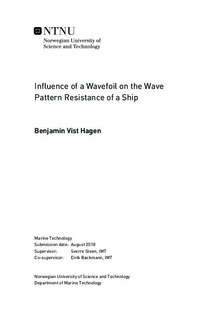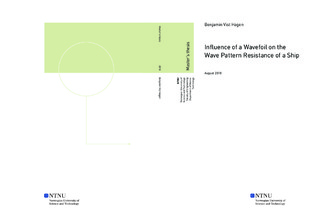| dc.description.abstract | The Reynolds-averaged Navier-Stokes equation has been numerically solved in order to study the interaction between the steady wave patterns of a wavefoil and ship hull, using the open source software OpenFOAM. Turbulence is modelled using the k-omega SST model. Theories applied concerning wave resistance, hydrofoils and computational fluid dynamics are described. A detailed description of methods used in setting up the numerical analyses are given, with important aspects to consider in computational fluid dynamics included.
A thorough literature study has shown the positive aspects of a wavefoil in creating a thrust force in waves, and by so reducing the total resistance and fuel consumption. However, in calm water conditions there will be an interaction between the steady wave patterns of the wavefoil and ship hull, increasing the total resistance. This interaction effect is studied further in this thesis.
All the Numerical analyses uses the Duisburg Test Case ship model hull due to the availability of the geometry in OpenFOAM and reference data. The wavefoil is modelled with a NACA 0018 cross-section profile and a sharp trailing edge. Further, the wavefoil has zero angle of attack relative to the undisturbed flow.
A double body study on the bare ship hull shows little variation in frictional resistance with varying grid density and resolution of the boundary layer. The form factor was found to be k = 0.086 from the double body analysis, yielding a relative difference of -8.5% when compared to available reference data.
Analyses on the bare hull, including a free surface, was performed in order to find the calm water resistance and steady wave patterns for three forward speeds. Systematic mesh and time step independence studies were performed in order to reduce error. Results show that for Fn=0.209 and Fn=0.218 the resistance is respectively underestimated by 10.35% and 10.78% when compared to model test results. Nevertheless, the results are considered stable and physical, but possible improvements have been discussed. Letting the model be free to heave and pitch, or running the simulation with sinkage and trim data from model tests, may have resulted in closer resistance predictions with respect to model tests.
Results for the ship hull with the wavefoil show that the calm water total resistance increases relative to the bare hull, even though the wavefoil produces a thrust force. The relative difference between the total resistance of the ship hull with the wavefoil and the bare ship hull for Fn=0.209, Fn=0.218 and Fn=0.226, is respectively found to be 8.43%, 8.00% and 8.14%. By inspection of the wave elevations on the ship hull and the steady wave patterns, it is found that the wavefoil amplifies the bow wave and alters the wave pattern. A reason for the amplification of the bow wave is found to be a negative angle of attack on the wavefoil from the flow due to the ship hull. This causes a wave crest being formed on the free surface directly above the wavefoil. Thus, the wavefoil in this study affects the steady wave pattern resistance in a negative manner.
To avoid amplification of the bow wave, the wavefoil can be rotated, giving it a positive angle of attack relative to the inflow. This may cause a wave through to be formed on the free surface above the wavefoil and cancellation of the bow wave. Further, the wavefoil should have a longitudinal position where the wave-making due to the wavefoil and the ship bow are out of phase, which will yield a cancellation effect. Assuming linearity, forces in calm water and forces due to incoming waves can be superimposed, meaning that the negative interaction effect on the wave pattern will be present in waves also. In a design phase, it therefore is recommended to consider these aspects, such that the interaction effect is also accounted for in waves. | |

